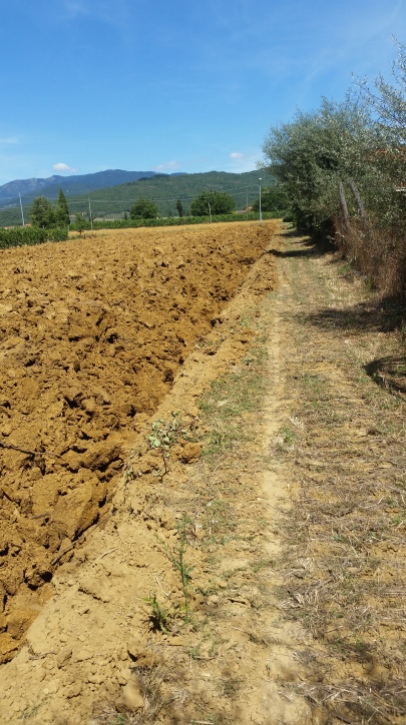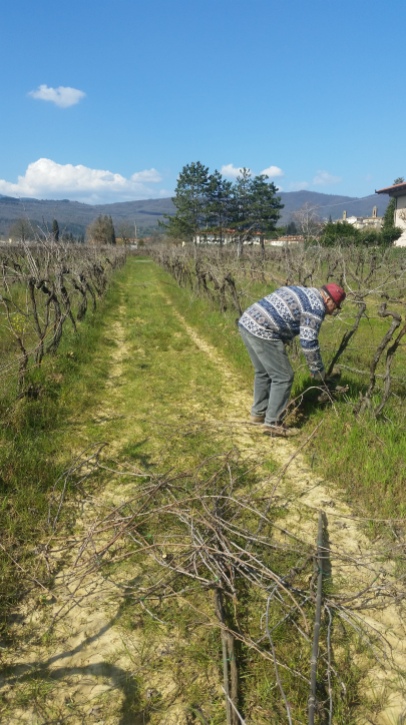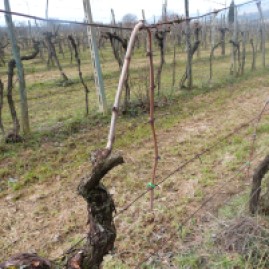This is the story of our idea and dream: the new beautiful vineyard.
For reading this story start from the bottom of this post…….and please write your impressions and your emotions!
Have a good reading!
Step 19. August 2018:
New Vineyard is growing – Google Map

Our project is taking shape. We are proud of taking care of the beauty of the area. It is a wonderful gift we give to all of us and to future generations.
Step 18. July 2018 :
Vineyard & Wonderful landscape
Step 17. June 2018:
Vineyard and its splendor (with roses)
What a splendor to see the vineyards with roses.
Our fixed thought is “Beauty will save the world” and also what Prince Leopold of Tuscany thought about Tuscany “functional aesthetics” – the beauty and functionality that coexist together … what an intelligent thing!
Maybe you did not know that …
Besides being an ornamental plant, the rose can perform a preventive function in the vineyards.
According to the common practice it is possible to prevent such diseases by observing a rose plant, placed near the rows (generally it is placed at the head of the rows). In fact, this plant tends to manifest symptoms in advance of the vine itself (about a week before).
The rose, therefore, would have the function of warning the farmer that, acting promptly through treatments based on copper (for peronospora) or sulfur (for oidium), will be able to block the infection in time.
Step 16. 31 December 2017:
Vineyard is sleeping
And so the first winter has arrived for our vines ..
Even the vines, like human beings, rest. Winter is the moment when everything stops in nature, preparing for the next spring.
Sh sh sh Silence ..
Now they rest in a deep sleep!
Step 15. October 2017:
Vineyard in Fall
Step 14. September 2017:
Vineyard is growing well
Like the puppies cared for with care and love by Renato Bianchi, the small vines are growing very well. We are very proud! Our dream is taking shape.
Step 13. July 2017:
Placing poles and wire metal
After planting the plants, we now place the poles and the metal wires to support them for when they are older.
Step 12. June 2017:
Little vines are growing despite the drought
In one of the hottest summers of the century, second only to 2003, the real risk was drought. Fortunately, and thank God for a week after having planted it, a long rain of two whole days has come, saving the vines from drought.
Step 11. May 2017:
Planting new grapevines.
Now it’s time to put the plants …. carefully, tidily and in perfect lines. We decided to put a small plant every 80 cm to get a good quality of the grapes. Renato and his helpers worked hardly.
Step 10. April 2017:
New Vine plants arrived
In April 2017, kept as if they had been a treasure in gold, diamonds and emeralds, the very precious 11.300 vine plants arrived in a cold store directly from the company Marchi e Volpe.
The entire production process takes place entirely within and under the direct control of the company. The processing is carried out with the utmost care to maintain an optimal health and morphological condition of the cuttings according to the clonal selections from which they derive.
The packing of the cuttings in nylon bags inside stackable cartons and the storage of refrigerated cells inside allows a perfect preservation at constant temperature and humidity. All under the control of public bodies and institutions that ensure the good health status of mother plants and nurseries.
In 2016 with our agronomist Dr. Guido Fatucchi of the Social Winery of Arezzo (Cantina dei Vini Tipici dell’Aretino) we analyzed the organoleptic characteristics of the soil and based on that they identified the typology of vine plants:
- ANCELLOTTA 24.8%
- SANGIOVESE 75%
- MALVASIA 0,1%
- TREBBIANO TOSCANO 0,1%
To produce in Castiglion Fibocchi the wine that follows the Chianti Wine DOCG Colli Aretini protocol
Step 9. April 2017:
Ready to Plant

The great moment has arrived ……… The land has been worked divinely. And with great attention all the old vines have been removed and it has been plowed several times ….. it’s spring where everything starts.
Step 8. September 2016:
Last works before planting
We leveled the field for the last time before planting the new vines. And now we let sleep the ground for all winter 2016 until spring 2017
Step 7. August 2016:
Deep soil plowing
To ensure greater fertility to the soil of the new vineyard we plowed more than 1 meter deep. Renato had called Mr. Croci an expert in the plowing of vineyards with his big bulldozer and his big coulter.
The purpose of the break is to create conditions of softness, even if temporary, even at a certain depth, so that the roots of the trees expand easily. In fact, in non-broken soil, the roots develop more superficially and the plants are more easily subject to eradication and more susceptible to drought. It is carried out with a super heavy rubberized / crawler agricultural tractor.
Step 6. July 2016:
Leveling the field
We have leveled the ground before plowing.
Step 5. June 2016:
Collection of old vines
Despite the great work many roots of vines have remained. We have collected them in one single point in a large pile.
Step 4. Jube 2016:
The ground after the first plowing
Now every row of the old vineyard is plowed.
Step 3. May 2016:
Remove the plant vines with tractor
Renato with the tractor plowed the soil to remove the roots of the old vines
Step 2. April 2016:
The Old Vine Plants cutted
Now it’s all cut. And there are only small branches and roots of vines
Step 1. March 2016:
We begin to cut the old vine plants.
An old vineyard that has done a good job for over 40 years is retiring! Now let’s start cutting the old screws. The whole Bianchi family is collaborating. In the front row, Bianchi Renato and then Gianni and Marusca.
Step 0. September 2015:
We have a DREAM: Plant a new Vineyard!

A day of September 2015, after the last harvest, we decided to plant a new vineyard in the same place where my father in law Renato planted it in 1970.


- GOAL: To Plant new 11.300 vine trees and do a new harvest in September 2019
- COMPANY : Cappannelle Farm
- DIRECTOR: Renato Bianchi









































































































































